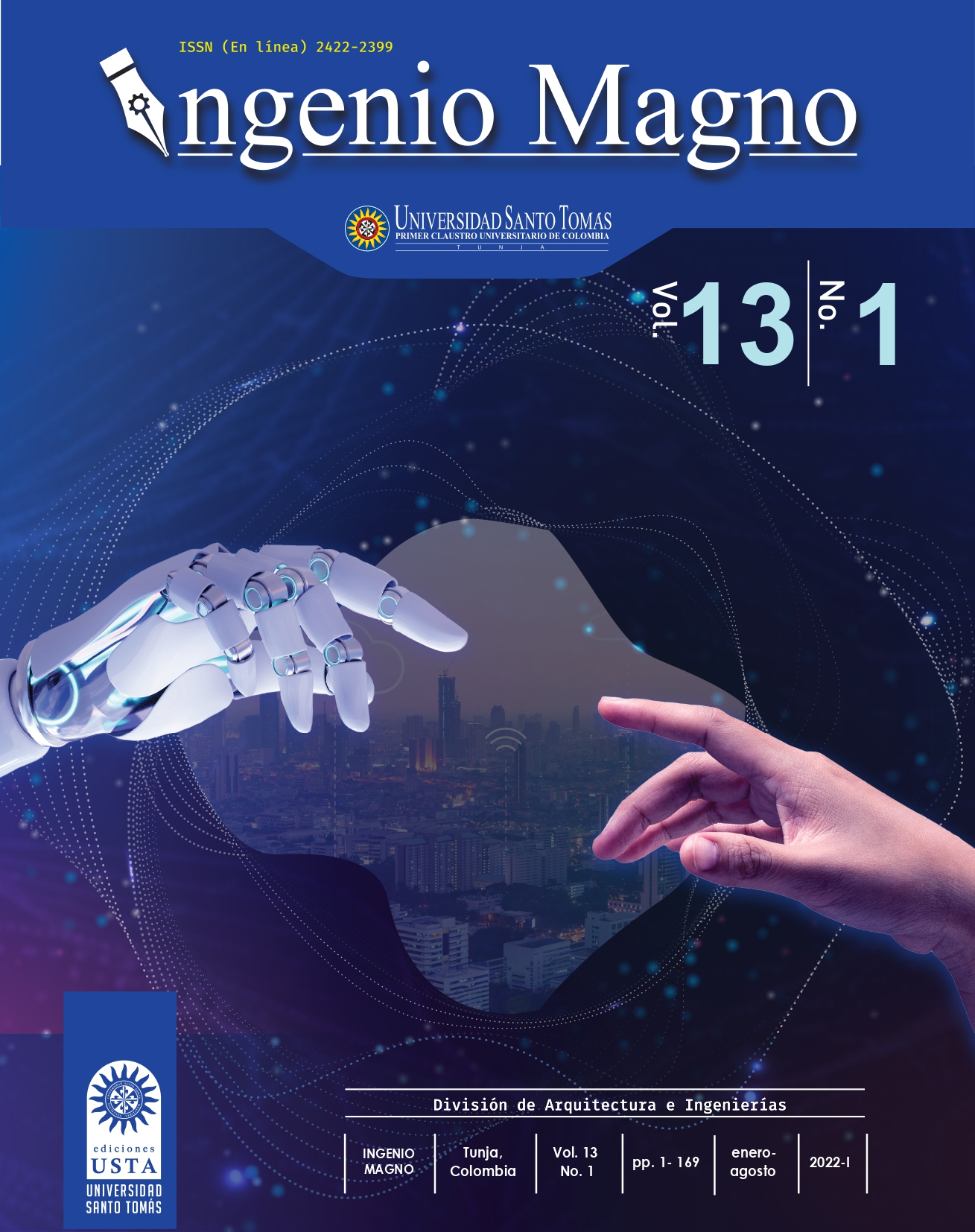Análisis de la red de logística humanitaria para la zona cafetera colombiana (departamento del quindío)
Contenido principal del artículo
Resumen
Descargas
Detalles del artículo
DECLARACIÓN DE ORIGINALIDAD DE ARTÍCULO PRESENTADO
Por medio del presente documento, certifico(amos) que el artículo que se presenta para posible publicación en la revista institucional INGENIO MAGNO del Centro de Investigaciones de Ingeniería Alberto Magno CIIAM de la Universidad Santo Tomás, seccional Tunja, es de mi (nuestra) entera autoría, siendo su contenido producto de mi (nuestra) directa contribución intelectual y aporte al conocimiento.
Todos los datos y referencias a publicaciones hechas están debidamente identificados con su respectiva nota bibliográfica y en las citas que se destacan como tal. De requerir alguna clase de ajuste o corrección, comunicaré(emos) de tal procedimiento con antelación a los responsables de la revista.
Por lo anteriormente expresado, declaro(amos) que el material presentado en su totalidad se encuentra conforme a la legislación aplicable en materia de propiedad intelectual e industrial de ser el caso, y por lo tanto, me(nos) hago (hacemos) absolutamente responsable(s) de cualquier reclamación relacionada a esta.
En caso que el artículo presentado sea publicado, manifiesto(amos) que cedo(emos) plenamente a la Universidad Santo Tomás, seccional Tunja, los derechos de reproducción del mismo.
Citas
[2] Arias, E. R. (10 de Diciembre de 2020). Investigación mixta. Obtenido de Economipedia.com: https:// economipedia.com/definiciones/ investigacion-mixta.html
[3] Baldasso, R., Ortiz, A., da Rosa, G., Soares, G., Crosato, E., & de Oliveira, R. (2019). The Role of the Humanitarian Logistics in the Kiss Nightclub Case. Journal of Service Science and Management, 859-871. doi:https://doi. org/10.4236/jssm.2019.127058
[4] Baltar, F., & Gorjup, M. T. (Octubre de 2012). Muestreo mixto online: Una aplicación en poblaciones ocultas. Intangible Capital, 8(1), 123-149. doi:http://dx.doi.org/10.3926/ic.294
[5] Bárcena, A., Prado, A., Samaniego, J., & Pérez, R. (2014). Manual para la Evaluación de Desastres. Organización de Naciones Unidas . Santiago de Chile: CEPAL. Obtenido de https://repositorio.cepal.org/ bitstream/handle/11362/35894/ S2013806_es.pdf?sequence=1&isAllow ed=y
[6] Cruz Roja. (2018). Cruz Roja Colombiana. Obtenido de Gestión del Riesgo de Desastres: https://www. cruzrojacolombiana.org/gestion-delriesgo- de-desastres-grd/
[7] El Tiempo. (20 de Noviembre de 2020). Huracan iota y otros desastres naturales en la historia de Colombia. Obtenido de El tiempo: https:// www.el t i empo.com/col ombia/ otras-ciudades/huracan-iota-y-otrosdesastres- naturales-en-la-historia-decolombia- 549713
[8] Gómez, D., Sarache, W., & Trujillo, M. (2017). Identificación y Análisis de una Red de Ayuda Humanitaria: Un Caso de Estudio. Información tecnológica, 115-124. doi:https://dx.doi. org/10.4067/S0718-07642017000200013
[9] Hernández Sampieri , R. (2018). METODOLOGÍA DE LA INVESTIGACIÓN: LAS RUTAS CUANTITATIVA, CUALITATIVA Y MIXTA. Ciudad de México: McGraw Hill Mexico. Obtenido de https://books.google.com.co/ books?id=5A2QDwAAQBAJ
[10] Hernández, J. L., & López, N. M. (2017). Factores de productividad y competitividad en redes empresariales de los sectores financiero, hotelero y de carga de la zona de el dorado, Bogotá D.C. Revista Chilena de Economía y Sociedad, 11(2), 51- 63. Obtenido de https://rches. utem.cl/ a r t iculos/factores-deproductividad- y-competitividad-enredes- empresariales-de-los-sectoresfinanciero- hotelero-y-de-carga-de-lazona- de-el-dorado-bogota-d-c/?utm_ source=rss&utm_medium=rss
[11] Herrera Arias, D. F. (2017). Consejo Departamental para la Gestión del Riesgo de Desastres. Armenia: Consejo Departamental Gestión del Riesgo de Desastres. Obtenido de quindio.gov.co/home/docs/items/ item_107/Estrategia_Departamental_ de_Respuesta_a_Emergencias_ Versión_1.1.pdf
[12] IFRC. (2022). Federación Internacional de Sociedades de la Cruz Roja y de la Media Luna Roja. Obtenido de ¿Qué es un desastre?: https://www.ifrc.org/ es/que-es-un-desastre
[13] Jaramillo Cárdenas, R. J. (2022). Tú y yo Somos Quindío . Obtenido de Datos Geográficos Básicos: https:// quindio.gov.co/el-departamento/ generalidades/datos-geograficosbasicos
[14] Kovács, G., & Spens, K. (2009). Identifying challenges in humanitarian logistics. International Journal of Physical Distribution & Logistics Management, 94- 114. Obtenido de https://www. emerald.com/insight/content/ doi/10.1108/09600030910985848/full/ html
[15] Lambiotte, R., Delvenne, J.-C., & Barahona, M. (2015). Laplacian dynamics and multiscale modular structure in networks. IEEE Transactions on Network Science and Engineering, 1(2), 76-90. doi:https://doi.org/10.1109/ TNSE.2015.2391998
[16] Ley 1523. (29 de Abril de 2012). Bogotá D.C., Colombia.
[17] LOPEZ-VARGAS, J. C., & CARDENASAGUIRRE, D. M. (2017). Humanitarian logistics management in the previus stages to the disaster: systematic review of the literature. Revista de Investigación, Desarrollo e Innovación, 7(2), 203-216. doi:https:// d o i . o r g / 1 0 . 1 9 0 5 3 / 2 0 2 7 8 3 0 6 . v7.n2.2017.6094
[18] Lozares, C. (1996). La Teoria de Redes Sociales. Papers: revista de sociología, 103-126. Obtenido de https://papers. uab.cat/article/view/v48-lozares/pdfes
[19] NC, E. (2021). Prepárate NC. Obtenido de Cuales son la etapas de un desastre: https://preparatenc.com/ cuales-son-las-etapas-de-un-desastre/
[20] PELÁEZ ORTIZ, A. M. (Noviembre de 2014). ANÁLISIS DE LA VULNERABILIDAD DEL SISTEMA TERRITORIAL PARA EL MUNICIPIO DE ARMENIA, QUINDÍO. Obtenido de Universidad Católica de Colombia: https://repository.ucatolica. edu.co/bitstream/10983/1792/1/ A n % C 3 % A 1 l i s i s - v u l n e r a b i l i d a d - sistematerritorial-Armenia.pdf
[21] QuestionPro. (22 de Junio de 2021). Muestreo mixto: Qué es, tipos, características y ventajas. Obtenido de QuestionPro: https://www. questionpro.com/blog/es/muestreom i x t o / # : ~ : t e x t = % C 2 % B F Q u % C 3 %A9%20es%20el%20muestreo%20 mixto,por%20el%20dise%C3%B1o%20 de%20investigaci%C3%B3n.
[22] UNGRD. (2018). Unidad Nacional para la Gestión del Riesgo de Desastres. Obtenido de Marco Estratégico: http://portal.gestiondelriesgo.gov.co/ marcoestrategico
[23] VIERA, O., MOSCATELLI, S., & TANSINI, L. (2012). Logística humanitaria y su aplicación en Uruguay. Gerencia Tecnológica Informática, 11(30), 47-56. Obtenido de https://dialnet.unirioja. es/descarga/articulo/4183132.pdf

